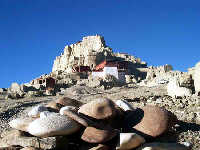|
Sudden Collapse of Guge Kingdom
( 2005-10-17 )
 A mound of yellow earth lies about 300 meters in height within the territory of Zhada County in Ngari Prefecture, on the southern bank of the River Langchen Khabab (or Elephant Spring River, which resembles an elephant drawing up water through its trunk). On this hill lie the ruins of a wall and a castle -- the most important remains of the ancient Guge Kingdom --, well known throughout the world. A mound of yellow earth lies about 300 meters in height within the territory of Zhada County in Ngari Prefecture, on the southern bank of the River Langchen Khabab (or Elephant Spring River, which resembles an elephant drawing up water through its trunk). On this hill lie the ruins of a wall and a castle -- the most important remains of the ancient Guge Kingdom --, well known throughout the world.
More than 1,000 years ago, a powerful kingdom with a splendid civilization was born here. But after over 700 years of rule, the kingdom was destroyed overnight by internal chaos and outside invasion.
The mystery at the core of the Guge Kingdom is the history of their downfall. Originally a peace-loving Buddhist state, the kingdom died out suddenly in 1635 under outside invasion. The problem is that historians don't quite know how.
Historians theorize that the neighboring Ladak Kingdom (thought to be modern Kashmir) invaded the Guge Kingdom -- after all, there are caches of weapons found at the ruins. However, listing war as the only probable cause seems too insufficient to explain the total overnight destruction of such a strong civilization with over 700 hundred years of history. It is as if thousands upon thousands of Guge people just disappeared over a matter of months.
But what they left behind is priceless. Their love forBuddhismand art prompted them to decorate their kingdom with Buddhist wall murals that are still in extremely good condition. Other Buddhist treasures include Buddhist scriptures written in gold and silver as well as numerous stupas (small towers used in Tibet as burial tombs or for storage of holy Buddhist scriptures). The Guge ruins also include caves filled withBuddhist statuesand murals.
While the reason for the Guge Kingdom's sudden collapse is still a mystery, its relics were put on China's cultural heritage list under first-class national protection in 1961.
|

